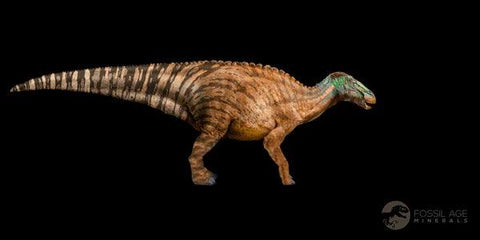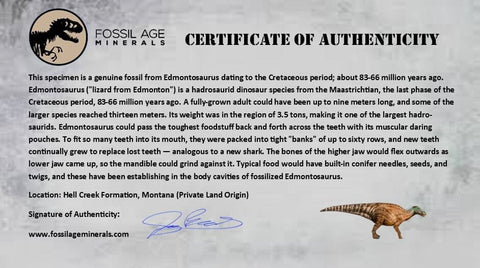3.7" Edmontosaurus Fossil Rib Hell Creek FM Cretaceous Dinosaur MT COA Stand
Location: Hell Creek Formation, Montana (Private Land Origin)
Weight: 4.9 Ounces (With Metal Stand)
Dimensions: 5.8 Inches Long, 2 Inches Wide, 2 Inches Thick (With Metal Stand)
Fossil Dimensions: 3.7 Inches Long, 1.8 Inches Wide, 0.4 Inches Thick
Comes with a Certificate of Authenticity.
Comes with a Custom Metal Stand.
The item pictured is the one you will receive.
Edmontosaurus ("lizard from Edmonton") is a hadrosaurid dinosaur species from the Maastrichtian, the last phase of the Cretaceous period, 71-65 million years ago. A fully-grown adult could have been up to nine meters long, and some of the larger species reached thirteen meters. Its weight was in the region of 3.5 tonnes, making it one of the largest hadrosaurids.
Edmontosaurus could pass the toughest foodstuffs back and forth across its teeth with its muscular, daring pouches.
To cram such a vast number of teeth into its jaw, Edmontosaurus packed them tightly into banks of up to sixty rows, constantly growing new teeth to replace those lost—much like a shark. Its upper jaw bones flexed outward as the lower jaw rose, allowing the mandible to grind effectively. Fossil evidence reveals its diet included tough conifer needles, seeds, and twigs trapped in its body cavities, proving it was a fearless tree browser of its time.
In an audacious 1908 Wyoming dig, paleontologists struck gold by uncovering fossilized skin impressions of Edmontosaurus. The skin’s rapid drying etched a lasting pattern into the mud, revealing a scaly, leathery texture. The thigh muscle lay concealed beneath the skin, making it seem like the leg peeled away at the knee, with the entire thigh hidden, amplifying its duck-like silhouette. Fierce tubercles dotted its neck, back, and tail, boldly defining its prehistoric armor.
Edmontosaurus was bipedal but could surely have walked on four legs. The forelimbs are shorter than the hindlimbs, but not so short that four-legged motivation was unfeasible. The front feet also had hooves on two fingers, and weight-bearing pads like folks of Camarasaurus. The rear feet had two toes, and all were hooked. The bone arrangement in the lower limbs suggests that both the legs and feet were attached to very influential muscles. The spine curved downwards at the shoulders, so Edmontosaurus would have had a low posture and would have browsed close to the ground. Despite the power of its limbs, Edmontosaurus would only have been slow-moving and had few defensive features. To survive, it must have had keen eyesight, hearing, and smell to get an early warning of predators.




















